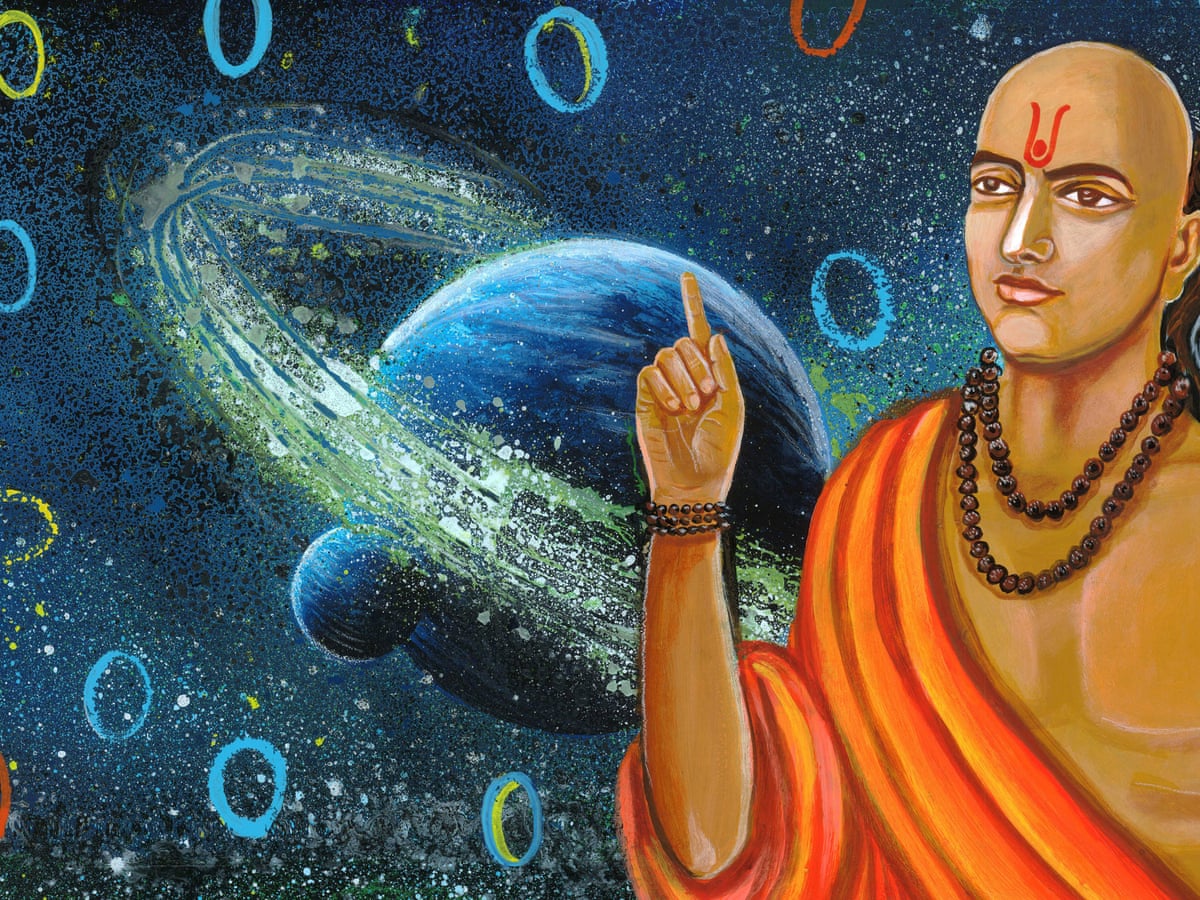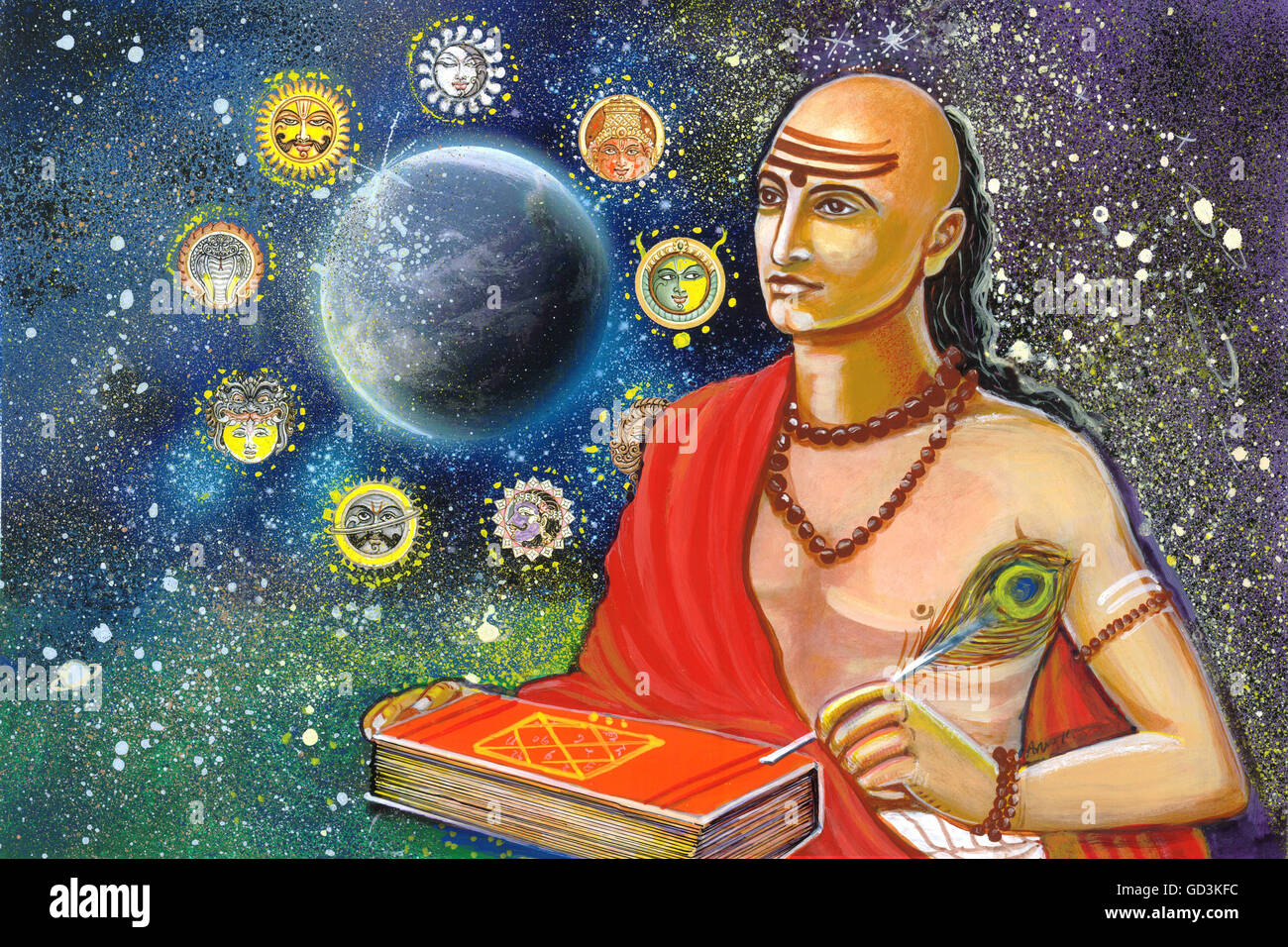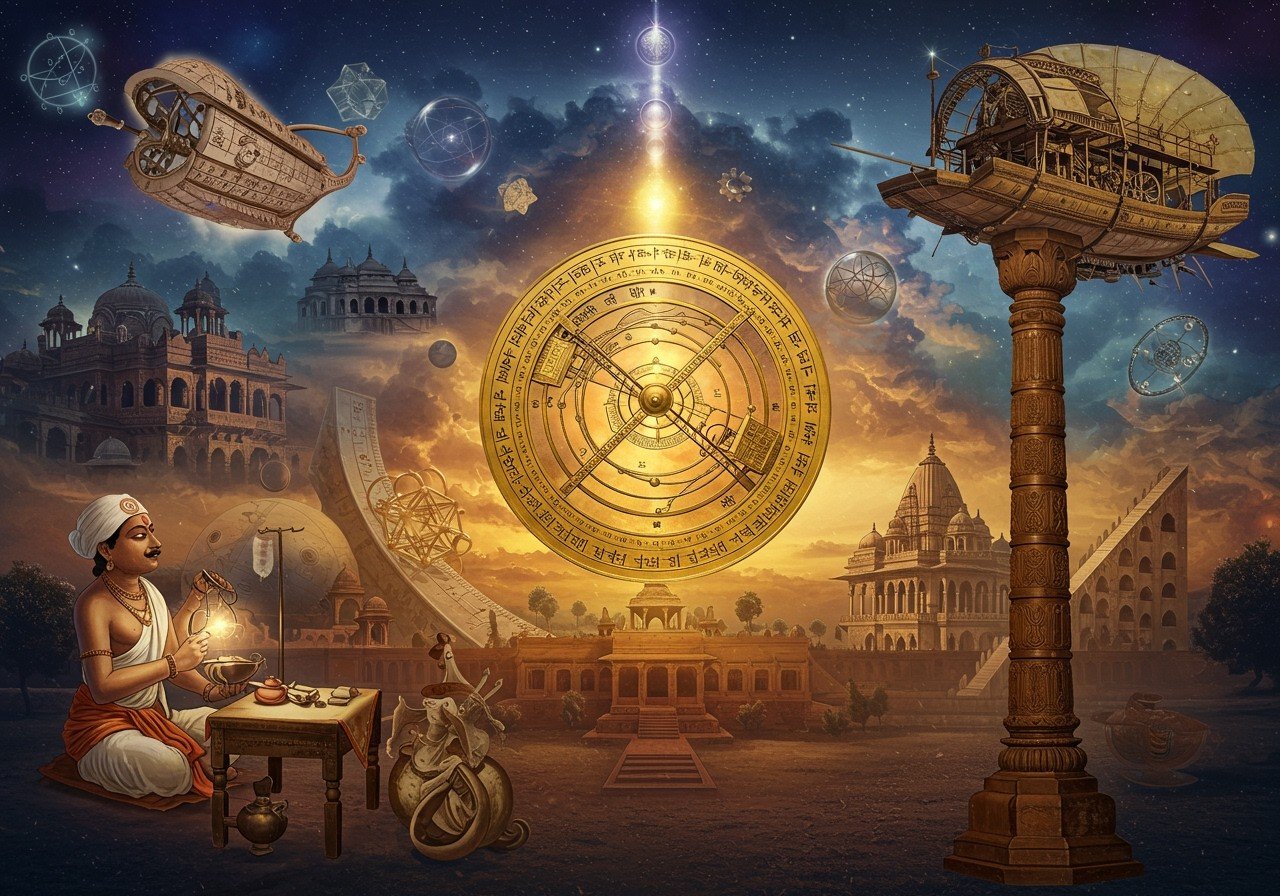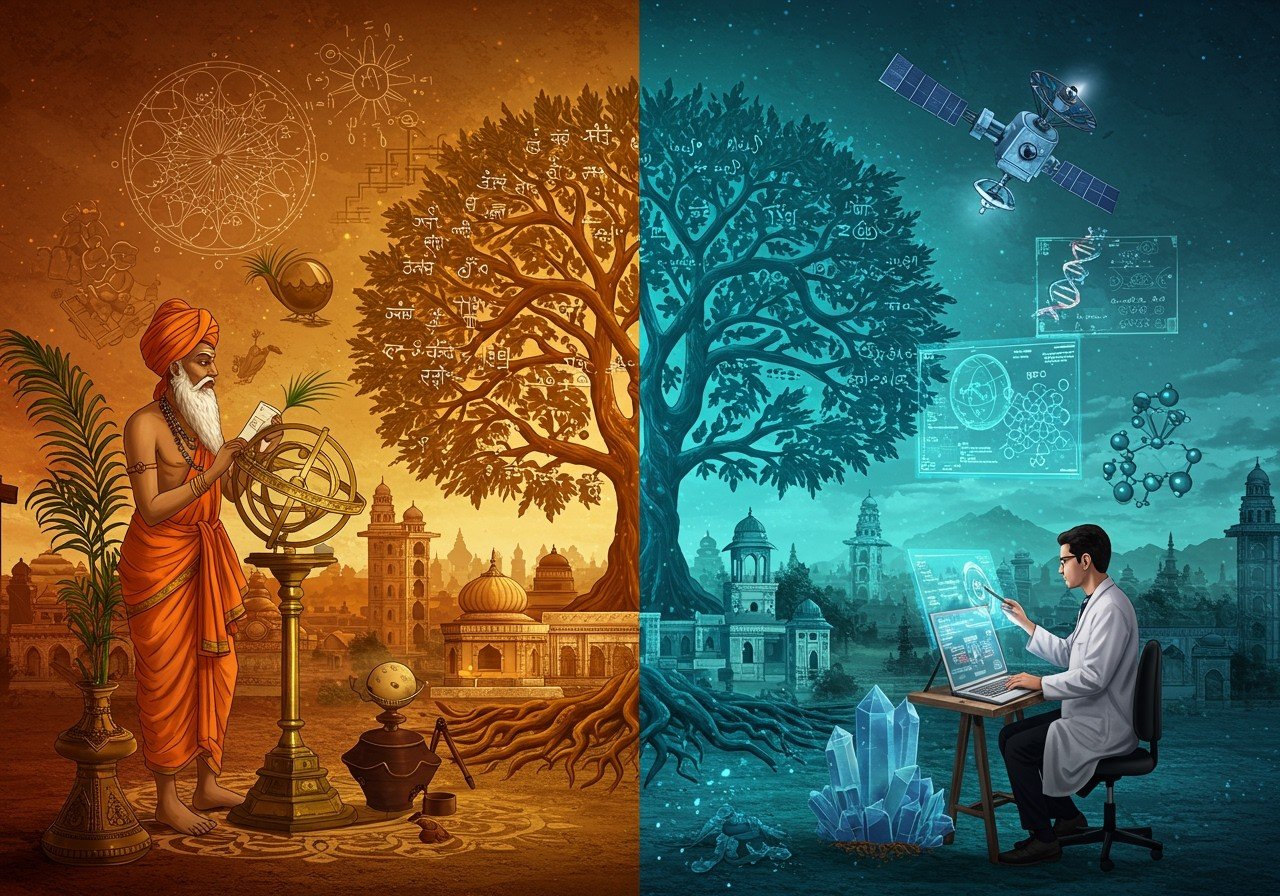Blending ancient Indian wisdom with modern neuroscience, the exploration reveals how the Rishis’ deep understanding of the senses—gross and subtle—anticipated many sensory modalities now recognized by science. From the Bhagavad Gita’s vision of the self mastering the senses, to Patanjali’s pratyahara and Ayurveda’s reliance on inner perception, the journey uncovers a unified view of human perception as both a physical and metaphysical bridge between self and universe. By integrating these insights into meditation, education, health, and conscious living, individuals can cultivate a richer sensory map, deepen self-awareness, and align with the timeless pursuit of harmony between mind, body, and cosmos.

Beyond the Five – Ancient Indian Wisdom and Modern Science on the Human Senses
I. Introduction: From Aristotle to the Upanishads – A Journey Beyond the Five Senses
While Aristotle gave the world a five-sense framework, the sages of Sanatana Dharma spoke of a far richer tapestry of perception — where the mind, intuition, and consciousness itself are senses.
A. The Western Five-Sense Model
When most people think about perception, they instinctively name five senses: sight, hearing, smell, taste, and touch. This neat classification originates with Aristotle, whose framework shaped the philosophical, medical, and scientific discourse of the Western world for over two millennia.
- Sight (vision) – considered the noblest sense in Greek thought, linked to knowledge and reason.
- Hearing (audition) – valued for the transmission of wisdom and music.
- Smell (olfaction), taste (gustation), and touch (tactile sense) – often regarded as more “animalistic” in classical philosophy, though vital for survival.
The reason this model endured was not only Aristotle’s intellectual influence but also its simplicity. It aligned neatly with observable organs and could be tested in everyday life. In modern education, we still inherit this “five windows to the world” idea — despite neuroscience revealing far more senses (like balance, temperature, proprioception, and pain).
B. Ancient Indian Perspective
In the spiritual and philosophical traditions of India, perception was never limited to five physical senses. The Vedantic and Yogic texts describe a multidimensional system of indriyas — faculties through which beings interact with the world.
- The Panchendriyas (Five Sense Organs) – Jnana Indriyas
These correspond to the organs of knowledge (jnana means “knowledge” or “awareness”):
- Chakshus (eyes) – sight
- Shrotra (ears) – hearing
- Ghrana (nose) – smell
- Rasana (tongue) – taste
- Tvak (skin) – touch
- The Organs of Action – Karma Indriyas
Equally important are the five organs of action, which enable interaction with the world:
- Vāk (speech) – communication
- Pāṇi (hands) – grasping, holding, creating
- Pāda (feet) – movement
- Pāyu (anus) – elimination
- Upastha (genitals) – reproduction, creative energy
- The Mind as the Sixth Sense
The mind (manas) is described as the internal sense organ, coordinating and interpreting all sensory input. The Katha Upanishad (1.3.3) offers a profound analogy:
“The senses are the horses, the mind is the reins, the intellect is the charioteer, and the Self is the master of the chariot.”
Here, the senses are not independent; they are guided by the mind, which itself must be directed by higher wisdom (buddhi).
C. Purpose of the Article
This article seeks to weave together two great traditions of thought: the Western analytical approach, which began with Aristotle’s classification, and the Eastern spiritual approach, which sees perception as a union of body, mind, and consciousness. By integrating ancient Indian spiritual insight with modern neuroscience, we will explore:
- How the senses are not merely physical detectors but gateways to awareness.
- How ancient Indian texts anticipated concepts now being validated by cognitive science.
- How perception can expand beyond sensory data into realms of intuition, empathy, and transcendence.
In doing so, we will uncover a timeless truth: perception is not just about receiving information — it is about transforming it into wisdom.

II. Defining a Sense – Science and Shastras
Modern neuroscience and ancient Indian philosophy agree on one thing — the senses are not mere passive channels; they are active gateways shaping reality. But where science stops at receptors and neural pathways, the Shastras extend the definition into realms of intellect, memory, and self-awareness.
A. The Scientific Lens
In modern physiology, a sense is typically defined as a specialized system that detects external or internal stimuli and transmits this information to the brain for processing.
- Sensation vs. Perception: Neuroscience distinguishes between sensation (raw data from sensory receptors) and perception (the brain’s interpretation and integration of that data). For example, photoreceptors in the eye detect light waves, but “seeing a sunset” is a perceptual experience constructed by the brain.
- Expanding Beyond Five: Contemporary science now recognizes far more than Aristotle’s five senses — including proprioception (body position), vestibular sense (balance), thermoception (temperature), and nociception (pain).
- Core limitation: Despite this expansion, the scientific model remains rooted in material inputs — all senses ultimately depend on physical interaction with measurable energy or matter.
B. The Spiritual Lens
In Sanatana Dharma, the definition of “sense” (Indriya) is both broader and deeper.
- Jnana Indriyas – The Cognitive Senses:
These correspond roughly to the Western five senses but are described as organs of knowledge:- Chakshu (sight)
- Shrotra (hearing)
- Ghrana (smell)
- Rasana (taste)
- Tvak (touch)
- Antahkarana – The Inner Instruments:
Beyond the physical, Vedanta describes four subtle faculties that participate in perception:- Manas – the mind, which receives and coordinates sensory inputs.
- Buddhi – the intellect, which discerns and judges.
- Chitta – the storehouse of memory and impressions.
- Ahamkara – the sense of self or ego, coloring perception with personal identity.
- Scriptural reference: Katha Upanishad (1.3.3) states: “The senses are the horses, the mind is the reins, the intellect is the charioteer, and the Self is the rider.” This metaphor elevates perception into a multi-layered process involving not only the senses but also mental and spiritual governance.
C. Intersection – Where Science Meets Shastra
When placed side-by-side, the parallels and differences are striking:
- Science’s strength: Detailed mapping of receptor-based sensory systems and their neural pathways.
- Shastra’s strength: Recognition that perception is inseparable from inner faculties like attention, discrimination, and self-awareness.
- Unified insight: Modern cognitive science acknowledges that attention and expectation shape perception — an echo of Vedantic teachings that the Manas and Buddhi actively filter and interpret sensory data.
- Key divergence: For Sanatana Dharma, consciousness (Atman) is the ultimate witness of all sensory experiences, a concept outside the scope of current empirical science.

III. The Core Five – Panchendriya in Vedantic Thought
In Vedantic philosophy, the human sensory framework is not merely biological—it is cosmological, elemental, and deeply spiritual. The five Jnana Indriyas (organs of knowledge) are seen as channels through which the soul (Atman) interacts with the manifest universe, each linked to one of the Pancha Mahabhutas (five great elements) and their subtle essences (tanmatras). The Taittiriya Upanishad and other Vedic texts map this relationship, showing that sensory perception is not accidental but an intentional design of creation.
A. Sight (Chakshu) – The Eye as the Sun’s Mirror
In Vedic cosmology, sight is linked to Surya (the Sun), the cosmic illuminator. Just as the Sun reveals the external world, the eye reveals the inner world of forms. The Chandogya Upanishad (3.13.7) suggests that the Sun is the eye of the entire universe—both literally (as light) and symbolically (as consciousness). Vision arises from the interaction of Chakshu with Rupa Tanmatra (the subtle form) and is sustained by the element Tejas (fire). Without light, there is no sight; without consciousness, there is no seeing.
B. Hearing (Shrotra) – Primacy of Sound
In the Vedantic hierarchy, Shabda (sound) is the most primal of all perceivable realities. The Rig Veda opens with the invocation to Vak (speech) and Nada (cosmic sound), and the Mandukya Upanishad places AUM as the fundamental vibration of the universe. The ear, as Shrotra, connects to the Akasha (ether) element. Hearing is not only a physical act but a spiritual reception—capturing vibrations that exist even before form manifests.
C. Smell (Ghrana) – The Earth’s Signature
The nose (Ghrana) is linked to Gandha Tanmatra (the subtle essence of smell) and corresponds to Prithvi (earth element). In Vedic thought, smell is the most material-bound of all senses, rooted in the solidity and stability of the Earth. The Bhagavata Purana notes that the Earth’s unique attribute is gandha, without which its very identity would dissolve. Smell connects us to memory, grounding the mind in both physical reality and ancestral lineage.
D. Taste (Jihva) – The Water’s Essence
Taste (Rasa) emerges when the tongue (Jihva) interacts with Rasa Tanmatra and is sustained by Jala (water element). Water carries sap, juice, and life-force, and taste is its intimate messenger. In Ayurveda, taste is not merely flavor but a diagnostic key to health—each taste influencing the doshas (vata, pitta, kapha). The Taittiriya Upanishad refers to Annam (food) and Rasa (essence) as stepping stones toward bliss (Ananda), making taste a spiritual as well as sensory experience.
E. Touch (Tvak) – The Whisper of Air
Touch, mediated by the skin (Tvak), corresponds to Sparsha Tanmatra and is linked to Vayu (air element). Vayu governs movement, circulation, and subtle life-force (prana). In Vedanta, touch is not limited to skin-to-skin contact—it is the perception of temperature, texture, vibration, and even emotional warmth. The Prashna Upanishad describes prana moving like air, touching and animating every part of the body.
F. Elemental Mapping – The Taittiriya Upanishad’s Model
The Taittiriya Upanishad and Samkhya philosophy give a precise mapping:
Sense Organ (Jnana Indriya) | Perceived Quality (Tanmatra) | Associated Element (Mahabhuta) |
Eye (Chakshu) | Form (Rupa) | Fire (Tejas) |
Ear (Shrotra) | Sound (Shabda) | Ether (Akasha) |
Nose (Ghrana) | Smell (Gandha) | Earth (Prithvi) |
Tongue (Jihva) | Taste (Rasa) | Water (Jala) |
Skin (Tvak) | Touch (Sparsha) | Air (Vayu) |
This mapping reveals a profound insight: sensory perception is not an isolated biological phenomenon—it is an elemental dialogue between the microcosm (human body) and the macrocosm (universe). The senses act as portals through which the individual soul experiences and remembers its unity with the cosmic order.

Senses Beyond Five – Known to the Rishis
- The Mind (Manas) as the Sixth Sense
- In Sanatana Dharma, Manas is not merely a thought engine but a sensory organ in its own right — the coordinator and interpreter of Jnana Indriya inputs.
- Bhagavad Gita 15.7: “Mamaivamsho jiva-loke jiva-bhutah sanatanah; manah-shasthanindriyani prakriti-sthani karshati” — “The living entities in this conditioned world are My eternal fragmental parts. Due to conditioned life, they are struggling with the six senses, including the mind.”
- The mind acts as a sieve: focusing attention, suppressing irrelevant input, and shaping reality based on samskaras (impressions).
- Inner Awareness (Antarjnana)
- The Rishis acknowledged a faculty beyond sensory and mental perception — a direct apprehension of truth without mediation.
- Found in the Upanishadic descriptions of aparoksha anubhuti — experiential knowledge that is immediate and self-evident.
- Related to the concept of Atma-Darshana (Self-realization) where knowing is not “about” something but being that reality.
- Yogic Awareness of Internal States
- Patanjali’s Yoga Sutras (II.54): “Sva-vishaya asamprayoge chittasya svarupa-anukara ivendriyanam pratyaharah” — “Pratyahara is the withdrawal of the senses from their objects, imitating the mind’s own form.”
- Pratyahara allows the practitioner to perceive inner phenomena — heartbeat, energy flow, subtle vibrations — without reliance on external input.
- Advanced yogic perception includes awareness of nadis (energy channels), chakras (energy centers), and the rhythms of prana.

V. Modern Neuroscience Confirms Ancient Intuitions
Purpose: To bridge the gap between Vedic spiritual insights and current scientific understanding of human sensory perception.
- Thermoception – Sense of Temperature
- Modern View: Specialized nerve endings detect heat and cold, transmitting signals to the brain.
- Vedic Parallel: Agni Tattva (Fire Principle) in Ayurveda and Samkhya philosophy — governs warmth, digestion, and transformation.
- Scriptural Link: Rig Veda hymns to Agni describe heat as both physical and divine energy essential to life.
- Equilibrioception – Sense of Balance
- Modern View: Vestibular system in the inner ear maintains equilibrium.
- Yogic Parallel: Awareness of posture (asana sthiti) and Sthira Sukham Asanam from Yoga Sutras46 — stability and comfort in posture.
- Vedic Context: Lord Shiva as Nataraja, balancing the cosmos through the Tandava, symbolizing cosmic and personal equilibrium.
- Nociception – Sense of Pain
- Modern View: Pain receptors protect the body from harm.
- Yogic View: Pain as a tapasya signal, prompting self-awareness and necessary change.
- Scriptural Link: Bhagavad Gita14 — “Matra-sparshas tu kaunteya…” — sensory experiences of heat, cold, pleasure, and pain are temporary and to be endured with courage.
- Proprioception – Awareness of Body Position
- Modern View: The brain integrates muscle, joint, and skin feedback to track bodily position.
- Yogic Parallel: Vinyasa Krama and martial arts in India (Kalaripayattu) develop heightened internal alignment and movement awareness.
- Scriptural Link: Hatha Yoga Pradipika — mastery of the body precedes mastery of the mind.
- Interoception – Awareness of Internal Body Signals
- Modern View: Detecting internal states like hunger, thirst, heartbeat, and breathing.
- Ayurvedic Parallel: Tridosha Theory (Vata – movement, Pitta – transformation, Kapha – structure) as body’s intrinsic self-monitoring system.
- Scriptural Link: Charaka Samhita — self-regulation through observation of bodily rhythms for disease prevention and longevity.

VI. The Time Sense – Kala as a Dimension of Perception
A. Chronoception in Neuroscience
From the brain’s perspective, time is not just an abstract idea but a perceivable dimension — a “sixth sense” in its own right. Chronoception refers to our ability to detect and measure the passage of time, whether through circadian rhythms that align our body clock with the 24-hour day or interval timing that helps us anticipate events within seconds or minutes. This internal clock is finely tuned by the suprachiasmatic nucleus in the brain, which responds to light cues, hormonal cycles, and even social patterns. When disrupted — as in jet lag or shift work — our health, mood, and cognitive function suffer, proving how deeply time perception is wired into our biology.
B. Kala in Sanatana Dharma
In Sanatana Dharma, Kala (Time) is not merely a measure — it is a cosmic principle, both a dimension and a deity. Time governs creation, preservation, and dissolution. It is cyclic in nature, from the micro-scale breath cycles of pranayama to the macro-scale progression of Yugas (Satya, Treta, Dvapara, Kali). The Bhagavad Gita 11.32 captures this transcendental dimension of time:
“Time I am, destroyer of worlds.”
Here, time is portrayed as the ultimate force, indifferent to human constructs, flowing beyond beginnings and endings. While modern science measures time linearly, the dharmic view sees it as a wheel — ever-revolving, repeating patterns at multiple scales.
C. Yogic Practices and Altered Time Perception
Advanced yogic practices suggest that time is not experienced uniformly.
- Pranayama can slow the perceived passage of time by synchronizing breath, heart rate, and mental activity.
- Meditation can create time dilation (a few minutes feeling like hours) or time contraction (hours passing in what feels like moments).
- States of samadhi are described as akalika anubhuti — timeless experiences beyond past, present, and future.
These altered states resonate with modern findings in neuroscience: attention, emotional arousal, and neural synchrony can profoundly shape our sense of time, mirroring what the rishis knew — that perception of time is as much a function of consciousness as it is of clocks.

VII. Subtle and Subconscious Senses in Ancient and Modern Contexts
- Magnetoreception
- Scientific View: Emerging evidence shows that certain proteins in the human retina and brain respond faintly to geomagnetic fields, potentially influencing orientation and navigation at a subconscious level.
- Spiritual Parallel: Ancient yogic traditions emphasize alignment with cosmic directions — many meditation and temple rituals prescribe facing East, believed to harmonize human energy with solar and geomagnetic flows.
- Vibration and Energy Sensitivity
- Scientific View: Specialized mechanoreceptors in the skin and muscles detect micro-vibrations, some even below conscious awareness, shaping balance, touch precision, and environmental sensing.
- Spiritual Parallel: Yogic and Ayurvedic disciplines describe Prana as the subtle life-force that can be “felt” in oneself and others; advanced practitioners report perceiving another person’s energetic state — the aura — as variations in warmth, tingling, or flow.
- Extrasensory Analogues
- Scientific & Animal Kingdom View: Many animals demonstrate senses humans lack — echolocation in bats, polarized light detection in bees, electroreception in certain fish — showing that “known” senses are not universal.
- Spiritual Parallel: Yogic and Puranic texts describe higher faculties: divya shrotra (clairaudience) — the ability to perceive sounds beyond normal hearing — and divya chakshu (clairvoyance) — perceiving events or entities beyond ordinary sight. These are framed not as “supernatural” but as refined extensions of natural human capacities achievable through discipline and inner purification.

VIII. The X Sense – Intuition, Buddhi, and Higher Knowing
- Intuition as Recognized in Indian Philosophy
- Buddhi in the Bhagavad Gita (Chapter 10, Verse 10) is described as the divine intelligence given to those devoted to truth — the ability to discern reality beyond sensory illusions (Maya).
- The Upanishads often place Buddhi above the mind (Manas) and senses, in the hierarchy of self-mastery (Katha Upanishad, I.3.10–12).
- In Yoga Sutra26, Patanjali emphasizes Viveka-Khyati — discriminative knowledge — as the path to liberation.
- Buddhi is not mere rationality; it is a supra-sensory faculty that can “see” the truth even before empirical confirmation.
- The Third Eye (Ajna Chakra)
- Located between the eyebrows, Ajna is regarded as the seat of higher awareness in yogic anatomy.
- Associated with Ishwara in yogic philosophy, it symbolizes awakening of jnana (wisdom) and intuitive sight.
- Ancient texts like the Shiva Samhita and Hatha Yoga Pradipika describe Ajna Chakra activation leading to clairvoyance, telepathy, and insight into the past, present, and future.
- In iconography, deities like Shiva are depicted with the third eye to represent destruction of ignorance and seeing reality in its totality.
- Modern Interpretation
- Neuroscience identifies intuition as rapid, subconscious pattern recognition — integrating vast prior experience without conscious reasoning.
- Functional MRI studies show that intuitive decisions activate areas like the anterior cingulate cortex and insula, which are also linked to emotional regulation and interoception.
- While modern science often limits “intuition” to brain computation shortcuts, ancient Indian thought integrates it into a spiritual framework where Buddhi connects with cosmic intelligence (Mahat Tattva).
- Emerging research into altered states of consciousness through meditation and psychedelics reveals overlaps with descriptions of expanded awareness in yogic states like Savikalpa Samadhi and Nirvikalpa Samadhi.

Why an Expanded Sensory Map Matters
- Spiritual Practice — Refining Inner Awareness
- Sanatana Dharma: The Upanishads describe human perception not as limited to five senses, but as instruments (indriyas) that can be transcended to access Atman (the Self).
- Bhagavad Gita6: “For him who has conquered the mind, the mind is the best friend; for one who has failed to do so, the mind will remain the greatest enemy.” — highlighting sensory mastery as key to spiritual liberation.
- Application: Yogic techniques like pratyahara (withdrawal of senses) and dharana (focused concentration) are enhanced when practitioners understand subtle senses like proprioception, chronoception, and energy sensitivity.
- Health and Healing — Ancient Diagnostics Meet Modern Biofeedback
- Ayurveda: Relies heavily on antar-jnana (inner knowledge) and trividha pariksha (threefold diagnosis — observation, touch, questioning) which require strong interoceptive skills.
- Modern parallels: Biofeedback, heart rate variability monitoring, and gut-brain axis awareness echo Ayurvedic self-assessment practices.
- The subtle awareness of imbalance before symptoms manifest aligns with preventive care principles in both Ayurveda and modern integrative medicine.
- Education — Integrating Ancient and Modern Sensory Science
- Gurukul tradition: Training involved shravanam (deep listening), mananam (reflection), and nididhyasanam (meditation), which sharpened multiple sensory and cognitive faculties.
- Modern pedagogy: Neuroscience supports multisensory learning for better retention and creativity.
- Curriculum concept: Teach children about lesser-known senses, linking yogic breathing, meditation, and environmental awareness with STEM-based sensory science.
- Conscious Living — Sensory Awareness for Dharmic Decision-Making
- Bhagavad Gita58: “When, like a tortoise withdrawing its limbs, he withdraws his senses from the sense-objects, then his wisdom becomes steady.”
- Being attuned to subtle perceptions — such as intuitive warning signals, environmental shifts, or emotional undercurrents — improves ethical, sustainable, and compassionate choices.
- Encourages living in samyama (balanced restraint), leading to clarity, harmony with nature, and alignment with dharma.

X. Conclusion: Rediscovering the Rishis’ Vision
- Key Insight
Ancient Indian wisdom did not merely hint at a deeper map of human perception—it explicitly charted it. Long before neuroscience began cataloguing chronoception, interoception, and magnetoreception, the Rishis of the Vedas and Upanishads spoke of Kala, Buddhi, Pratyahara, and the Third Eye as living, trainable realities. The modern rediscovery of these “hidden senses” is less a scientific breakthrough and more a return to truths humanity once knew. - The Unified View
From the Yogic perspective, senses are neither limited to the five gateways of physical experience nor isolated functions of biology—they are multi-layered bridges connecting the individual consciousness (Jivatma) to the cosmic whole (Paramatma). Science sees them as specialized neural systems; spirituality sees them as living threads between matter and awareness. Integrating these two views creates a more complete map—one that respects both measurable signals and immeasurable insight. - Invitation
We stand at a crossroads where technology can either dull our perception with overstimulation or awaken subtler faculties through conscious practice. Cultivate the “gross” senses with mindfulness and the “subtle” senses through meditation, breathwork, and disciplined self-inquiry. Listen to the rhythms of your body, the pulse of nature, and the whispers of intuition. In doing so, we not only enhance personal wellbeing but also touch the timeless vision of the Rishis. - Participate and Donate to MEDA Foundation
The MEDA Foundation is dedicated to making such integrative learning accessible—bringing together ancient knowledge, modern science, and practical education. Your support can help create workshops, research initiatives, and school programs that awaken both physical and subtle perception. Contribute to this journey—participate, donate, and become part of a living movement towards conscious, sensory-rich living.
Book & Scripture References:
- Katha Upanishad – Mind as reins of senses.
- Bhagavad Gita7, 11.32 – Six senses, cosmic time.
- Patanjali Yoga Sutras – Pratyahara and sensory control.
- Taittiriya Upanishad – Senses and elements.
- Sankhya Karika – Eleven sense organs (5 Jnana Indriyas, 5 Karma Indriyas, 1 Manas).
- A Natural History of the Senses – Diane Ackerman.
- Livewired – David Eagleman.









